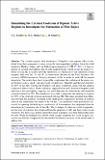Files in this item
Simulating the coronal evolution of bipolar active regions to investigate the formation of flux ropes
Item metadata
| dc.contributor.author | Yardley, Stephanie Louise | |
| dc.contributor.author | Mackay, Duncan Hendry | |
| dc.contributor.author | Green, Lucie | |
| dc.date.accessioned | 2021-01-08T10:30:02Z | |
| dc.date.available | 2021-01-08T10:30:02Z | |
| dc.date.issued | 2021-01-06 | |
| dc.identifier | 260661478 | |
| dc.identifier | b65698d9-1f31-433b-8645-af626b0bf37c | |
| dc.identifier | 85098764932 | |
| dc.identifier | 000608032200004 | |
| dc.identifier.citation | Yardley , S L , Mackay , D H & Green , L 2021 , ' Simulating the coronal evolution of bipolar active regions to investigate the formation of flux ropes ' , Solar Physics , vol. 296 , 10 . https://doi.org/10.1007/s11207-020-01749-2 | en |
| dc.identifier.issn | 0038-0938 | |
| dc.identifier.other | ORCID: /0000-0001-6065-8531/work/86538023 | |
| dc.identifier.uri | https://hdl.handle.net/10023/21244 | |
| dc.description | Funding: S.L.Y. would like to acknowledge STFC for support via the Consolidated Grant SMC1/YST025. D.H.M. would like to thank STFC, the Leverhulme Trust and the ERC under the Synergy Grant: The Whole Sun, grant agreement no. 810218 for financial support. L.M.G. is thankful to the Royal Society for a University Research Fellowship and the Leverhulme Trust. | en |
| dc.description.abstract | The coronal magnetic field evolution of 20 bipolar active regions (ARs) is simulated from their emergence to decay using the time-dependent nonlinear force-free field method of Mackay, Green, and van Ballegooijen (Astrophys. J. 729, 97, 2011). A time sequence of cleaned photospheric line-of-sight magnetograms, which covers the entire evolution of each AR, is used to drive the simulation. A comparison of the simulated coronal magnetic field with the 171 and 193 Å observations obtained by the Solar Dynamics Observatory (SDO)/Atmospheric Imaging Assembly (AIA), is made for each AR by manual inspection. The results show that it is possible to reproduce the evolution of the main coronal features such as small- and large-scale coronal loops, filaments and sheared structures for 80% of the ARs. Varying the boundary and initial conditions, along with the addition of physical effects such as Ohmic diffusion, hyperdiffusion and a horizontal magnetic field injection at the photosphere, improves the match between the observations and simulated coronal evolution by 20%. The simulations were able to reproduce the build-up to eruption for 50% of the observed eruptions associated with the ARs. The mean unsigned time difference between the eruptions occurring in the observations compared to the time of eruption onset in the simulations was found to be ≈5 hrs. The simulations were particularly successful in capturing the build-up to eruption for all four eruptions that originated from the internal polarity inversion line of the ARs. The technique was less successful in reproducing the onset of eruptions that originated from the periphery of ARs and large-scale coronal structures. For these cases global, rather than local, nonlinear force-free field models must be used. While the technique has shown some success, eruptions that occur in quick succession are difficult to reproduce by this method and future iterations of the model need to address this. | |
| dc.format.extent | 5465376 | |
| dc.language.iso | eng | |
| dc.relation.ispartof | Solar Physics | en |
| dc.subject | Active regions | en |
| dc.subject | Magnetic fields | en |
| dc.subject | Corona | en |
| dc.subject | Models | en |
| dc.subject | QB Astronomy | en |
| dc.subject | QC Physics | en |
| dc.subject | DAS | en |
| dc.subject.lcc | QB | en |
| dc.subject.lcc | QC | en |
| dc.title | Simulating the coronal evolution of bipolar active regions to investigate the formation of flux ropes | en |
| dc.type | Journal article | en |
| dc.contributor.sponsor | Science & Technology Facilities Council | en |
| dc.contributor.sponsor | Science & Technology Facilities Council | en |
| dc.contributor.sponsor | EPSRC | en |
| dc.contributor.sponsor | European Research Council | en |
| dc.contributor.institution | University of St Andrews. Applied Mathematics | en |
| dc.identifier.doi | https://doi.org/10.1007/s11207-020-01749-2 | |
| dc.description.status | Peer reviewed | en |
| dc.identifier.grantnumber | ST/S000402/1 | en |
| dc.identifier.grantnumber | ST/N000609/1 | en |
| dc.identifier.grantnumber | N/A | en |
| dc.identifier.grantnumber | 810218 | en |
This item appears in the following Collection(s)
Items in the St Andrews Research Repository are protected by copyright, with all rights reserved, unless otherwise indicated.

